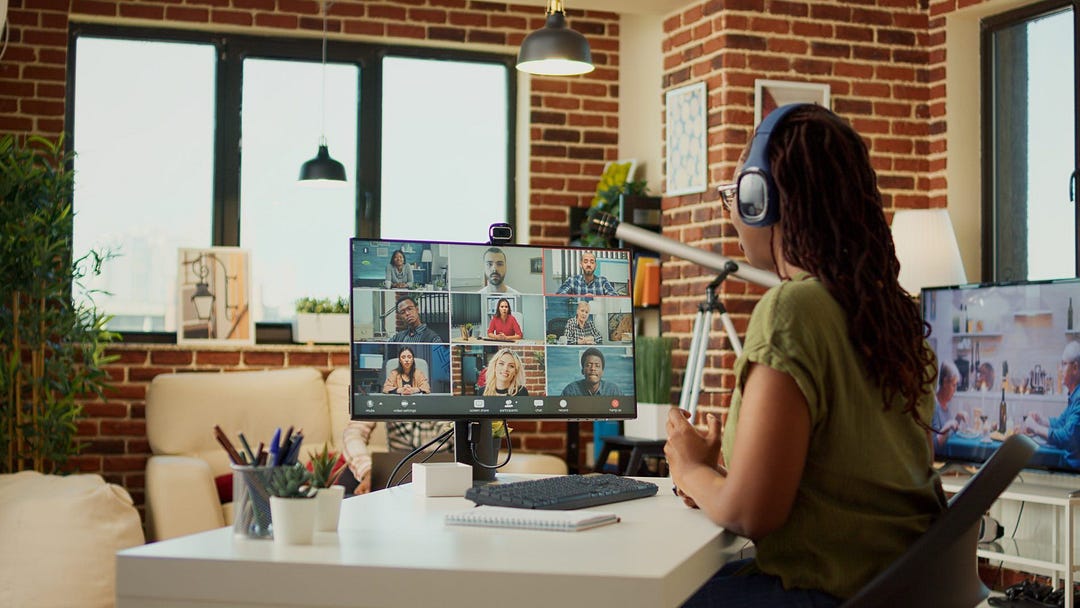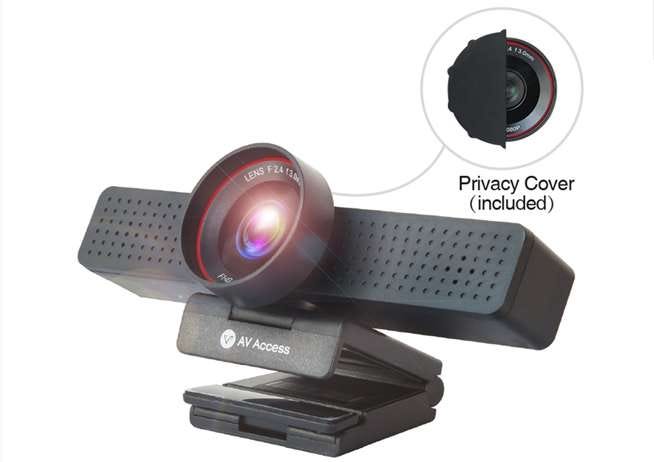
Table of Contents
- What is a Webcam?
- Advantages of Webcams
- Disadvantages of Webcams
- What is a Conferencing Room Camera?
- Advantages of Conferencing Room Cameras
- Disadvantages of Conferencing Room Cameras
- Main Differences Between Webcams and Conferencing Room Cameras
- Choosing the Right Camera for Your Needs
- Conclusion
- More Resources
As the lines between remote work, live streaming, and traditional office collaboration continue to blur, understanding the functionality and appropriateness of different camera types has become essential. Choosing between a webcam and a conferencing room camera significantly impacts the quality and efficacy of digital communications, whether for individual use, like live streaming, remote learning, and working from home, or for collective environments such as meeting rooms.
What is a Webcam?

A webcam is chiefly a personal device favored for one-on-one online interactions, live broadcasting, and remote desktop work. The AV Access Bizeye50 webcam is a testament to the evolution of the humble webcam — boasting a broad 85° field of view and 1080P resolution, sufficient for the majority of personal use cases. Plus, with its competitive pricing, the Bizeye50 webcam presents itself as a solid, budget-friendly option for those seeking quality without a substantial investment.
Advantages of Webcams
The AV Access Bizeye50 webcam exemplifies the primary advantages expected of modern webcams — simplicity and efficiency. Easy to set up with their plug-and-play design, these devices are more than adequate for the casual user. Their affordability and compact size make them a smart choice for students, freelancers, and professional streamers alike.
Disadvantages of Webcams
Despite their advancements, webcams are sometimes challenged by limited functionalities such as a fixed field of view and lower performance in varied lighting situations. While suitable for individual users, they can be restrictive when trying to capture larger groups or more dynamic scenes.
What is a Conferencing Room Camera?

On the flip side, conferencing room cameras like the AV Access Bizeye80 camera are engineered for spacious settings where multiple participants need to collaborate with remote counterparts. This camera is a step up, featuring a 120° ultra-wide angle lens, making it more fitting for conference room environments. They can comfortably encompass every participant, making sure that every voice is seen, as well as heard, during a remote meeting.
Advantages of Conferencing Room Cameras
Conferencing room cameras offer premium optics and sophisticated feature sets geared toward corporate standards. With the AV Access Bizeye80 camera, for instance, the expanded field of view and finer video clarity uplift the meeting room experience. When combined with the eShare W80 wireless conferencing system, the effectiveness of these cameras multiplies, allowing for comprehensive interaction and engagement among all meeting attendees.
Disadvantages of Conferencing Room Cameras
While superior in functionality, conferencing cameras imply higher costs and often require more complex installation and operation. Their sophisticated features might necessitate an IT specialist for setup and troubleshooting, adding to the overall investment when compared to a standard webcam.
Main Differences Between Webcams and Conferencing Room Cameras
The difference between webcams like the Bizeye50 webcam and conferencing systems incorporating the Bizeye80 camera comes down to scale and complexity. While webcams satisfy the demands of individual users with their cost-effectiveness and ease of use, conferencing cameras are designed for professional settings where more robust solutions are needed to manage group communications.
Choosing the Right Camera for Your Needs
Selecting the proper camera equipment depends largely on your interaction scale and environment specifics. For daily use in solitary settings, the Bizeye50 webcam and its offerings could be ample. Yet for those operating in an enterprise or educational setting, opting for a Bizeye80 camera with its broader view, paired with the eShare W80 wireless conferencing system, becomes a strategic choice, promising a more productive and inclusive meeting experience.
Conclusion
Whether opting for a personal webcam or a professional-grade conferencing room camera, understanding each device’s use case ensures optimal communication flow. The Bizeye50 webcam serves most individual needs with simplicity and affordability, while the Bizeye80 camera, especially when integrated with the eShare W80 wireless conferencing system, elevates the group conferencing experience. As the tools of our digital interactions evolve, equipping yourself with the knowledge to discern between devices like these ensures you remain at the forefront of efficient and effective digital communication.
More Resources
You may also be interested in other blogs:
- 5 Tips for Choosing the Right Webcam for Hybrid Conferences
- 3 Benefits of Using AI Webcam for Virtual Conferences
- AI Webcams Are Rising: 5 Things You Should Know
- 4 Scenarios for Using AI Webcams: From Education to Entertainment
- Video Bar vs. Webcam: Which One Should You Choose for Video Conference?

No comments yet